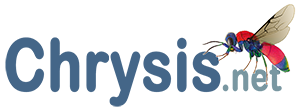Last updated on December 1st, 2023
The fundamental morphologic features which distinguish chrysidids from the other wasps are:
- reduction of the number of the visible abdominal segments to 5 or less
- an internal ovipositor or genital tube, constituted by the remaining abdominal segments
- 11 antennal articles (flagellomeres), plus pedicel and scape
- labial palps with 3 articles and maxillar palps with 5 articles
- fore wings with 5 closed cells, or less, and
- hind wings without closed cells.
According to the Zoological Record, Chrysidids are ranked in the taxonomic hierarchy as Aculeate Wasps, wasps equipped by a stinging apparatus. But, according to the present-day classifications, the traditional sections (infraorders) ‘Terebrantia’ (‘Parasitica’) and ‘Aculeata’ of the Suborder ‘Apocrita’ have been abandoned in the direction of taxonomy based on Superfamilies.
The Family Chrysididae comprises 5 Subfamilies and 83 Genuses. Their taxonomy down to the Genus level is as follows:
- Class Insecta
- Order Hymenoptera
- Suborder Apocrita
- Series Aculeata (obsolete)
- Superfamily Chrysidoidea
- Family Chrysididae
- Subfamily Cleptinae
- Cleptes*
- Cleptidea
- Subfamily Amiseginae
- Adelphe
- Afrosega
- Alieniscus
- Amisega
- Anachrysis
- Anadelphe
- Atoposega
- Baeosega
- Bupon
- Cladobethylus
- Colocar
- Duckeia
- Exopapua
- Exova
- Imasega
- Indothrix
- Isegama
- Kimseya
- Kryptosega
- Leptosega
- Magdalium
- Mahinda
- Microsega
- Myrmecomimesis
- Nesogyne
- Nipponosega
- Obenbergerella
- Perissosega
- Reidia
- Rohweria
- Saltasega
- Serendibula
- Subfamily Loboscelidiinae
- Loboscelidia
- Rhadinoscelidia
- Subfamily Chrysidinae
- Tribe Allocoeliini
- Allocoelia
- Tribe Elampini
- Adelopyga
- Chrysellampus*
- Colpopyga*
- Diplorrhos
- Elampus*
- Exallopyga
- Haba
- Hedychreides
- Hedychridium*
- Hedychrum*
- Holophris
- Holopyga*
- Microchridium
- Minymischa
- Muesebeckidium
- Oligogaster
- Omalus*
- Parachrum
- Philoctetes*
- Prochridium
- Pseudolopyga
- Pseudomalus*
- Xerochrum
- Tribe Kimseyini
- Kimseya
- Tribe Chrysidini
- Allochrysis
- Argochrysis
- Caenochrysis
- Ceratochrysis
- Chrysidea
- Chrysis*
- Chrysura*
- Chrysurissa
- Euchroeus*
- Exochrysis
- Gaullea
- Ipsiura
- Istiochrysis
- Morphochrysis*
- Neochrysis
- Odontochrydium
- Pentachrysis*
- Pleurochrysis
- Praestochrysis*
- Primeuchroeus
- Pseudochrysis*
- Spinolia*
- Spintharina*
- Spintharosoma
- Stilbichrysis
- Stilbum*
- Trichrysis*
- Tribe Allocoeliini
- Subfamily Parnopinae
- Cephaloparnops
- Isadelphia
- Parnopes*
- Subfamily Cleptinae
- Family Chrysididae
- Superfamily Chrysidoidea
- Series Aculeata (obsolete)
- Suborder Apocrita
- Order Hymenoptera
* the asterisk indicates the presence of the Genus in Europe.
Copyright, Authorship, and Ownership statements
All text and images of this page are copyright ©️ Chrysis.net unless otherwise stated - please see individual cases for authorship and copyright details. The specimens pictured are from the authors' or other collaborators' personal collections and from the collections of various museums. Unless otherwise specified, the whole content of this web site is for personal, non-commercial, scientific, and educational purposes given proper accreditation to the page from which they were derived are provided, and under Chrysis.net Terms and Conditions.
For citation purposes
Agnoli G.L. & Rosa P. (2025) Systematics of Chrysididae, in: Chrysis.net website. Interim version 12 July 2025, URL: https://www.chrysis.net/chrysididae/systematics-of-chrysididae/.




